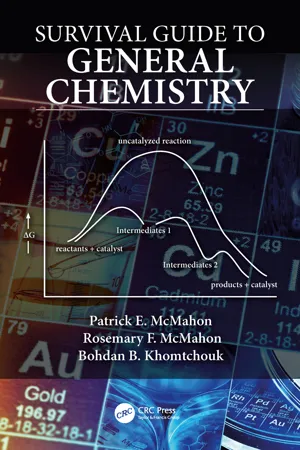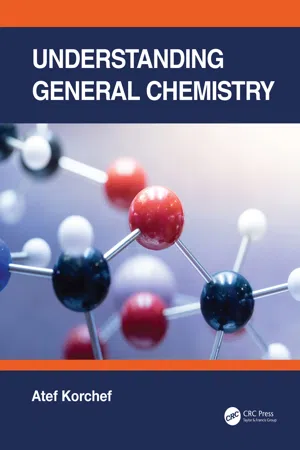Chemistry
Moles and Molar Mass
Moles are a unit used to measure the amount of substance in chemistry. One mole is equal to the number of atoms in 12 grams of carbon-12. Molar mass is the mass of one mole of a substance and is expressed in grams per mole. It is calculated by summing the atomic masses of the elements in a chemical compound.
Written by Perlego with AI-assistance
Related key terms
Related key terms
1 of 4
Related key terms
1 of 3
5 Key excerpts on "Moles and Molar Mass"
- eBook - ePub
- Jeffrey Gaffney, Nancy Marley(Authors)
- 2017(Publication Date)
- Elsevier(Publisher)
Chapter 1 . The fundamental units of a substance may be atoms, molecules, ions, or chemical formula units, depending on the type of substance.The number of atoms in 12.000 g of 12 C has been determined to be equal to 6.022 × 1023 . So, one mole of any element always contains 6.022 × 1023 atoms, one mole of any covalent compound always contains 6.022 × 1023 molecules, and one mole of any ionic compound always contains 6.022 × 1023 chemical formula units. The number 6.022 × 1023 by itself is known as Avogadro's number (NA), after the nineteenth century scientist Amedeo Avogadro. It is actually a conversion factor between the number of moles and the number of fundamental units in a substance.N A=or 6.022 ×6.022 ×mol10 2310 23mol− 1The importance of the mole concept to chemistry is that it can be extended to the molecular level. If one mole of oxygen reacts with two moles of hydrogen to form two moles of water,(1)O 2+H 2→2H 2Othen one atom of oxygen reacts with two atoms of hydrogen to form one molecule of water.O + 2H →H 2OThe mass of one mole of a substance is called the molar mass of that substance. Since the element 12 C was used to define the mole as the number of atoms in 12.000 g, which is also the atomic mass of 12 C, then the molar mass of any element is equal to the atomic mass of that element in units of grams/mole. Similarly, the molar mass of any covalent compound is equal to its molecular mass (also called molecular weight) in units of grams/mole and the molar mass of an ionic compound is equal to its formula mass (or formula weight) in units of grams/mole. The molecular mass is the mass of a molecule calculated as the sum of the atomic masses multiplied by the number of atoms of each element in the molecule. For example, the molecular mass of methane with the molecular formula of CH4 - eBook - ePub
- Patrick E. McMahon, Rosemary McMahon, Bohdan Khomtchouk(Authors)
- 2019(Publication Date)
- CRC Press(Publisher)
5 An Introduction to Moles and Molar MassI GENERAL CONCEPTS A mole is a counting number; the value of one mole = 6.02214 ×1023 objects. In principle, this counting number can be applied to any countable object; however, in practice, the mole is used only for objects as small as atoms or molecules. One mole of pennies would cover the area of the state of Illinois to a height of about 10 miles.COUNTING NUMBERSpair = 2 dozen = 12score = 20gross = 144mole = 6.02214 ×1023The mole counting number is based on a specific standard. One mole is defined as equal to a number represented by the exact number of atoms present in exactly 12 grams of the isotope carbon-12. The carbon-12 standard used for the definition of one mole is the same standard used for the definition of an amu. This results in the following relationships:The mass of one atom of carbon-12 is exactly 12 amu (by definition).The mass of one mole (6.02214 × 1023 ) of carbon-12 atoms is exactly 12 grams (by definition).Note that the conversion factor 1.66054 × 10−24 g/amu interconverts grams and amu’s. Calculate the number of amu’s per gram:The number of atoms (or ions or molecules) in one mole is identical to the number of amu in one gram.# a m u i n 1 g r a m== 61 gram1.66054 ×10g/amu− 24. 0 2 2 1 4× 102 3a m u / g r a mThe molar mass (MM) of an element is defined as the mass of one mole of average atoms of this element.The molar mass (MM = the mass of one mole of atoms) of any element is numerically equal to the average atomic mass of the element expressed in gram units; the units of MM = grams/moles.Recall that the mass of one average atom of an element is defined as the atomic mass (sometimes called atomic weight) and is listed in the periodic table. The definitions of amu and mole based on carbon-12, as described, produce the result that: - eBook - ePub
- Atef Korchef(Author)
- 2022(Publication Date)
- CRC Press(Publisher)
One mole (1 mol) contains 6.022 × 1023 entities (atoms, molecules, ions).The atomic mass (the mass of one atom) is the average mass of all the isotopes of an atom with respect to their abundances. The atomic masses of all elements are given in the periodic table of elements. The atomic mass is commonly expressed in atomic mass units (amu).1 a m u =g = 1.660 ×1 /N Ag10− 24- Example: A calcium (Ca) atom has a mass of 40 amu. The mass of calcium atom in g is (40/NA ) g = 6.642 × 10−23 g
The molecular mass is the sum ofthe atomic masses of all the atoms in the molecule. It is commonly expressed in atomic mass units (amu).- Example: One molecule of sulfuric acid (H2 SO4 ) contains two atoms of H, one atom of S and four atoms of O. The molecular mass M of sulfuric acid is
M = 2 ×+ 1 ×atomic mass of H+ 4 ×atomic mass of Satomic mass of O=+2 × 1+1 × 32= 98 amu4 × 16The mass of one sulfuric acid molecule in g is (98/NA )g = 1.627 × 10−22 gFor monatomic elements, the molar mass (mass of one mole, abbreviated as M or Mwt ) is the numerical value on the periodic table expressed in g mol−1 .- Example: The atomic mass of O is equal to 16 amu and the molar mass of O is equal to 16 gmol−1 .
For molecules, the molar mass is the sum of the molar masses of each of the atoms in the molecular formula.- Example: A molecule of H2 O contains two H atoms and one O atom. The atomic mass of O is 16 amu and the atomic mass of H is 1 amu. The molecular mass of H2 O is equal to 16 + 2 × 1 = 18 amu and the molar mass of H2 O is equal to 18 gmol−1
- eBook - ePub
Understanding Basic Chemistry
The Learner's Approach
- Kim Seng Chan, Jeanne Tan(Authors)
- 2014(Publication Date)
- WSPC(Publisher)
CHAPTER 4MOLE CONCEPT, FORMULA, AND STOICHIOMETRYIn Chapter 3 , we learned that matter is made up of fundamental particles such as an atom, ion, or molecule. But these particles are extremely small objects, both in size and mass. If the mass of a small toothpick is about 1.00 × 10−2 g, the mass of a hydrogen atom (1.67 × 10−24 g) is 1.67 × 1022 times lighter than the mass of the toothpick. Or if your mass is 10 kg, you are about 5.97 × 1024 times lighter than the mass of our planet Earth.Atoms and molecules react in specific ratios to form compounds. In the laboratory, however, chemists work with bulk quantities of reactants, which are measured by mass. They need to know the relationship between the mass of a given sample and the number of atoms or molecules contained in that mass of a given sample. So, how do scientists know the number of particles in the mass of a matter in the laboratory? How many ions are present in a tablespoon of salt? How many molecules are present in a dew drop? How many atoms are present in a speck of sand? A standard for counting such small particles is needed!4.1 The MoleThis standard is known as the “mole.” The mole is based upon the carbon-12 isotope. In the beginning, scientists asked the following question: how many carbon-12 atoms are needed to have a mass of exactly 12 g (recall that scientists had already developed the concept of relative atomic mass)? So, what is this number?The number is known as the Avogadro’s number, L or NA , in honor of Amedeo Avogadro, though the number was not formulated by him. In fact, he just conceptualized the idea. Thus, L is defined as:Careful measurements yield a value of 6.022141 × 1023 mol−1 . It is difficult to imagine how large this number is. Let us try: if you have 6.02 × 1023 one-dollar notes and each day you spend $1,000, you are going to need 6.02 × 1020 days or 1.64 × 1018 years to finish it. The age of Earth is just about 4.54 × 109 - eBook - ePub
Understanding Bioanalytical Chemistry
Principles and Applications
- Victor A. Gault, Neville H. McClenaghan(Authors)
- 2013(Publication Date)
- Wiley(Publisher)
molekulargewicht , rather than referring to the burrowing mammal). Chemists who coined this term around 200 years ago were trying to quantify the chemical composition of gases, solids and liquids. For this they needed a universal unit of measurement so they could connect the mass of an atom (or molecule) with the number of atoms or molecules in any given compound. They decided to use Avogadro’s number.What is a mole?A mole is a term that represents a number; just like the word ‘dozen’ represents ‘12’, the word ‘mole’ represents 6.02 × 1023 (or 602 216 900 000 000 000 000 000). The term mole , while initially confusing, is extremely useful. To give an example: if we were to count the number of water molecules in a single drop it would be around 10 trillion (10 000 000 000 000), so rightly or wrongly chemists argue that it is easier to quantify such numbers in moles and thus cut down on the number of zeros!Why 6.02 × 1023 ?This number is ‘Avogadro’s number’, named after the Italian physics professor who proposed that equal volumes of different gases at the same temperature contain the same number of molecules. In its simplest form, 1 mol of any substance contains 6.02 × 1023 atoms or molecules of that substance, and as this relationship was first put forward by Avogadro they named this number after him.Concept of the moleA defined mass of an element (its atomic weight) contains an exact number of atoms, that is, Avogadro’s number. Therefore, for any given molecule, one mole of the substance has a mass (in grams) equal (numerically) to the atomic mass of the molecule. One mole is the number of atoms in exactly 12 thousandths of a kilogram (i.e. 12 g) of carbon (12
Index pages curate the most relevant extracts from our library of academic textbooks. They’ve been created using an in-house natural language model (NLM), each adding context and meaning to key research topics.
Explore more topic indexes
Explore more topic indexes
1 of 6
Explore more topic indexes
1 of 4




